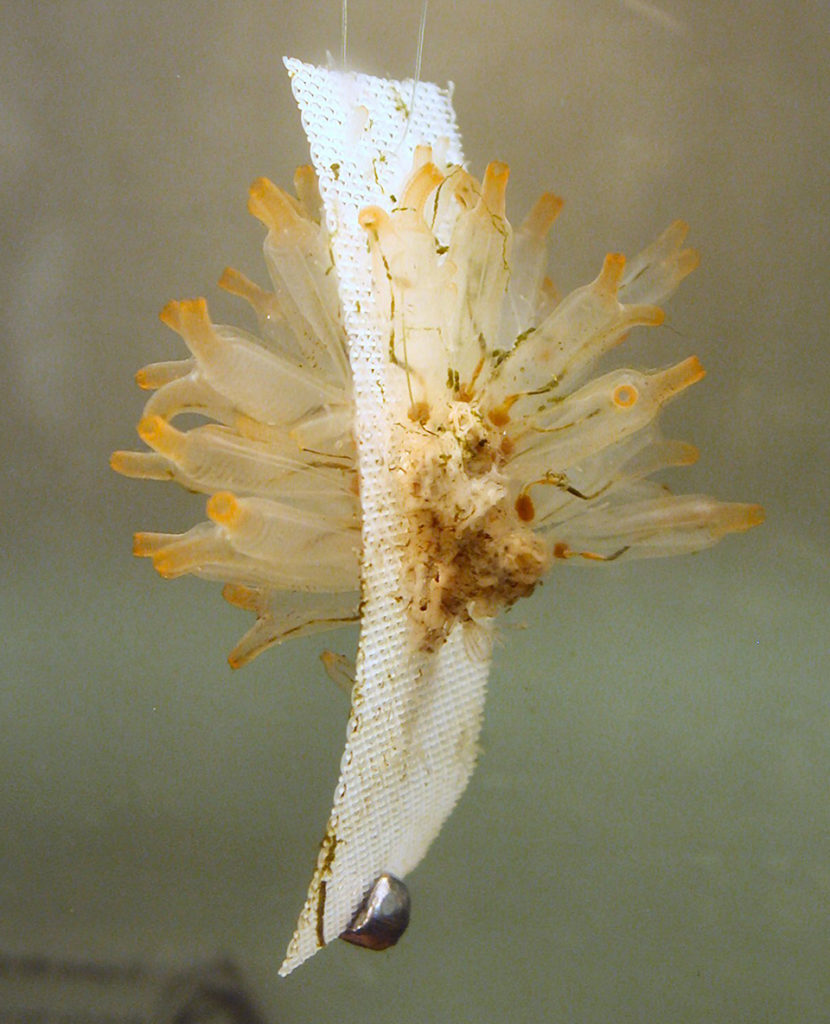Feeding regimes tested at Harbor Branch Oceanographic Institute

In Australian testing, good growth rates and increased biosynthesis of target compounds were achieved in cultured E. turbinata and A. corrugate, marine species whose metabolites have antitumor properties. The results suggested that in-vitro culture is a viable method for supplying some ascidian and sponge metabolites for drug development and production.
Several ascidian and sponge species contain biologically active metabolites that have pharmaceutical potential as drugs. Since most of these bioactive metabolites are found at low concentrations within the ascidians or sponges, large amounts of biomass are required for drug development or production. Because large-scale harvesting would likely be environmentally destructive and expensive, alternative supply methods are needed.
In vitro culture
One possible method of supplying sufficient and sustainable quantities of bioactive metabolite is in vitro culture, whereby the ascidians or sponges are grown under controlled conditions in tanks on land. However, for in vitro culture to succeed, it is vital to develop appropriate feeding regimes that promote growth and biosynthesis production of the target metabolites.
Both ascidians and sponges filter suspended particles of generally less than 20-µm size. In 2002-2003 research at Harbor Branch Oceanographic Institute in Florida, USA, the author based feeding regimes on the natural concentrations of suspended particles that his test organisms experience in the wild.
Mangrove ascidian
The mangrove ascidian Ecteinascidia turbinata produces ecteinascidins, metabolites that have strong antitumor properties. Currently undergoing clinical trials, this species is a colonial ascidian consisting of individual zooids held together by a common stolon, a rootlike structure that also attaches the colony to the substratum.
In the author’s tests, colonies of approximately 25 zooids were attached to nylon mesh and placed in aquariums containing 15 l of filtered seawater that was changed daily. The colonies were fed three microalgae – Chaetoceros gracilis, Isochrysis galbana and Nannochloropsis sp. – either individually or in combination, at a concentration of 80,000 cells per millileter, a natural concentration (1 NC).
Growth was greatest overall for colonies fed a monospecific diet of I. galbana and a multispecific diet of C. gracilis and I. galbana, probably because the two diets best met the nutritional requirements of E. turbinata. To determine the optimal food concentration for in vitro culture, colonies were fed both diets at one, two, and four times the natural concentration. After four weeks, E. turbinata fed the “natural-level” diets had grown little, while colonies fed the higher concentrations doubled in size.
This clearly showed the phenomenal growth rates that can be obtained with in vitro culture when good diets are used. Another promising finding was that in vitro culture can promote target metabolite biosynthesis, with farmed E. turbinata colonies containing four times the normal concentration of ecteinascidins.
Caribbean sponge
Found on Caribbean coral reefs, the sponge (Axinella corrugata) produces stevensine, a metabolite with antitumor properties. In research by the author, individual A. corrugata were collected and cut into smaller pieces or explants and placed into aquariums containing filtered seawater.
For eight weeks, the explants were fed a multispecific diet of bacteria, yeast, and microalgae at four different concentrations: 1 NC (200,000 bacteria per millileter with 23,000 microalgae and yeast per millileter), 3 NC, 5 NC, and 5 + 1 NC (5 NC of bacteria and 1 NC of microalgae and yeast).
The growth of A. corrugata varied greatly among the food concentrations. Explants fed the 3 NC diet increased in weight by 22 percent (Fig. 1). In contrast, explants fed the 1 NC diet did not grow, while explants fed the higher-concentration diets lost weight.
These results indicated that growth of A. corrugata increases as food concentration increases until a threshold is reached, at which high cell concentration has a negative impact. Reduced growth in the explants that received high-concentration diets may have resulted from the additional cells blocking the sponges’ aquiferous systems, the structures that transport water throughout the sponges.
The concentration of food also greatly affected metabolite biosynthesis in A. corrugata. Explants fed the 3 NC diet had double the normal concentration of stevensine (Fig. 2). In contrast, stevensine concentration in explants fed the other diets was similar to that of wild sponges.
(Editor’s Note: This article was originally published in the December 2004 print edition of the Global Aquaculture Advocate.)
Now that you've finished reading the article ...
… we hope you’ll consider supporting our mission to document the evolution of the global aquaculture industry and share our vast network of contributors’ expansive knowledge every week.
By becoming a Global Seafood Alliance member, you’re ensuring that all of the pre-competitive work we do through member benefits, resources and events can continue. Individual membership costs just $50 a year. GSA individual and corporate members receive complimentary access to a series of GOAL virtual events beginning in April. Join now.
Not a GSA member? Join us.
Author
-
Alan Duckworth, Ph.D.
Australian Institute of Marine Science
P.O. Box 41321
Casuarina 0811
Northern Territory, Australia[117,97,46,118,111,103,46,115,109,105,97,64,104,116,114,111,119,107,99,117,100,46,97]
Tagged With
Related Posts

Responsibility
Pacific Islands communities support aquaculture development
Threats from overfishing and climate change highlight the need for alternative methods of local seafood production and economic advancement throughout the Pacific Islands. Ongoing work with giant clams, pearl oysters and crabs helps meet consumer needs and replenish stocks.

Responsibility
The odd wedge sea hare is useful as an ‘algae cleaner’
Marine gastropod molluscs known as sea hares are relatively unknown animals that have significant importance in biomedical research due to their particular nervous system. And because of their ability to consume large amounts of algae, they can be very useful in clearwater, marine aquaculture systems.

Responsibility
A look at integrated multi-trophic aquaculture
In integrated multi-trophic aquaculture, farmers combine the cultivation of fed species such as finfish or shrimp with extractive seaweeds, aquatic plants and shellfish and other invertebrates that recapture organic and inorganic particulate nutrients for their growth.

Intelligence
Hybrid soft corals could produce novel pharmaceuticals
Hybrid soft corals Sinularia maxima and S. polydactyla contain numerous compounds that have potential for important pharmaceutical activities.


